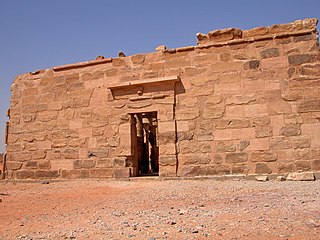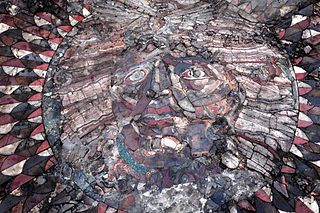Related Research Articles

Osiris is the god of fertility, agriculture, the afterlife, the dead, resurrection, life, and vegetation in ancient Egyptian religion. He was classically depicted as a green-skinned deity with a pharaoh's beard, partially mummy-wrapped at the legs, wearing a distinctive atef crown, and holding a symbolic crook and flail. He was one of the first to be associated with the mummy wrap. When his brother, Set, cut him up into pieces after killing him, Isis, his wife, found all the pieces and wrapped his body up, enabling him to return to life. Osiris was at times considered the eldest son of the earth god Geb and the sky goddess Nut, as well as being brother and husband of Isis, with Horus being considered his posthumously begotten son. In the Old Kingdom the pharaoh was considered a son of the sun god Ra who, after his death, ascended to join Ra in the sky. With the spread of the Osiris cult, however, there was a change in beliefs. He was also associated with the epithet Khenti-Amentiu, meaning "Foremost of the Westerners", a reference to his kingship in the land of the dead. Through syncretism with Iah, he is also a god of the Moon.

Isis was a major goddess in ancient Egyptian religion whose worship spread throughout the Greco-Roman world. Isis was first mentioned in the Old Kingdom as one of the main characters of the Osiris myth, in which she resurrects her slain brother and husband, the divine king Osiris, and produces and protects his heir, Horus. She was believed to help the dead enter the afterlife as she had helped Osiris, and she was considered the divine mother of the pharaoh, who was likened to Horus. Her maternal aid was invoked in healing spells to benefit ordinary people. Originally, she played a limited role in royal rituals and temple rites, although she was more prominent in funerary practices and magical texts. She was usually portrayed in art as a human woman wearing a throne-like hieroglyph on her head. During the New Kingdom, as she took on traits that originally belonged to Hathor, the preeminent goddess of earlier times, Isis was portrayed wearing Hathor's headdress: a sun disk between the horns of a cow.

Harpocrates was the god of silence, secrets and confidentiality in the Hellenistic religion developed in Ptolemaic Alexandria. Harpocrates was adapted by the Greeks from the Egyptian child god Horus, who represented the newborn sun, rising each day at dawn. Harpocrates's name was a Hellenization of the Egyptian Har-pa-khered or Heru-pa-khered, meaning "Horus the Child". Horus is represented as a naked boy with his finger to his mouth, a realisation of the hieroglyph for "child". Misunderstanding this gesture, the later Greeks and Roman poets made Harpocrates the god of silence and secrecy.

In ancient Egyptian religion, Apis or Hapis, alternatively spelled Hapi-ankh, was a sacred bull worshiped in the Memphis region, identified as the son of Hathor, a primary deity in the pantheon of ancient Egypt. Initially, he was assigned a significant role in her worship, being sacrificed and reborn. Later, Apis also served as an intermediary between humans and other powerful deities.

Empúries was an ancient city on the Mediterranean coast of Catalonia, Spain. Empúries is also known by its Spanish name, Ampurias. The city Ἐμπόριον was founded in 575 BC by Greek colonists from Phocaea. After the invasion of Gaul from Iberia by Hannibal the Carthaginian general in 218 BC, the city was occupied by the Romans. In the Early Middle Ages, the city's exposed coastal position left it open to marauders and it was abandoned.

Egypt was a subdivision of the Roman Empire from Rome's annexation of the Ptolemaic Kingdom in 30 BC to its loss by the Byzantine Empire to the Islamic conquests in AD 641. The province encompassed most of modern-day Egypt except for the Sinai, and was bordered by the provinces of Crete and Cyrenaica to the west and Judea, later Arabia Petraea, to the East. Egypt came to serve as a major producer of grain for the empire and had a highly developed urban economy. Aegyptus was by far the wealthiest Eastern Roman province, and by far the wealthiest Roman province outside of Italy. The population of Roman Egypt is unknown; although estimates vary from 4 to 8 million. In Alexandria, its capital, it possessed the largest port, and was the second largest city of the Roman Empire.

A serapeum is a temple or other religious institution dedicated to the syncretic Greco-Egyptian deity Serapis, who combined aspects of Osiris and Apis in a humanized form that was accepted by the Ptolemaic Greeks of Alexandria. There were several such religious centers, each of which was a serapeion or, in its Latinized form, a serapeum. An Egyptian name for the temple of Osiris-Apis was Pr-Wsỉr-Ḥp "House of Osiris-Apis".

Pozzuoli is a city and comune of the Metropolitan City of Naples, in the Italian region of Campania. It is the main city of the Phlegrean Peninsula.

The Luxor Temple is a large Ancient Egyptian temple complex located on the east bank of the Nile River in the city today known as Luxor and was constructed approximately 1400 BCE. In the Egyptian language it was known as ipet resyt, "the southern sanctuary". It was one of the two primary temples on the east bank, the other being Karnak. Unlike the other temples in Thebes, Luxor temple is not dedicated to a cult god or a deified version of the pharaoh in death. Instead, Luxor temple is dedicated to the rejuvenation of kingship; it may have been where many of the pharaohs of Egypt were crowned in reality or conceptually.

Serapis or Sarapis or Sorapis is a Graeco-Egyptian deity. The cult of Serapis was pushed forward during the third century BC on the orders of Greek Pharaoh Ptolemy I Soter of the Ptolemaic Kingdom in Egypt as a means to unify the Greeks and Egyptians in his realm. A serapeum was any temple or religious precinct devoted to Serapis. The cultus of Serapis was spread as a matter of deliberate policy by the Ptolemaic kings. Serapis continued to increase in popularity during the Roman Empire, often replacing Osiris as the consort of Isis in temples outside Egypt.

Serapis Bey, sometimes written as Serapis, is regarded in Theosophy as one of the Masters of the Ancient Wisdom; and in the Ascended Master Teachings is considered to be an Ascended Master and member of the Great White Brotherhood. He is regarded as the Chohan of the Fourth Ray. C. W. Leadbeater wrote that Henry Steel Olcott was given occult training by Serapis Bey when his own master, Morya, was unavailable. A series of letters to Olcott, alleged to be from Serapis, encouraging Olcott to support Blavatsky in the founding of the Theosophical Society were published in the book Letters from the Masters of the Wisdom.

The concept of Hellenistic religion as the late form of Ancient Greek religion covers any of the various systems of beliefs and practices of the people who lived under the influence of ancient Greek culture during the Hellenistic period and the Roman Empire. There was much continuity in Hellenistic religion: people continued to worship the Greek gods and to practise the same rites as in Classical Greece.

Menouthis was a sacred city in ancient Egypt, devoted to the Egyptian goddess Isis and god Serapis. The city was probably submerged under the sea as a result of catastrophic natural causes: earthquakes or Nile flood. Land in the bay area was subject to rising sea levels, earthquakes, and tsunamis, parts of it apparently becoming submerged after a process of soil liquefaction sometime at the end of the 2nd century BC.

Temple of Al-Maharraqa is an ancient Egyptian Temple dedicated to Isis and Serapis. It is located in al-Maharraqa, Lower Nubia, approximately 140 km (87 mi) south of Aswan on the southern border of the Roman empire.

The "Red Basilica", also called variously the Red Hall and Red Courtyard, is a monumental ruined temple in the ancient city of Pergamon, now Bergama, in western Turkey. The temple was built during the Roman Empire, probably in the time of Hadrian and possibly on his orders. It is one of the largest Roman structures still surviving in the ancient Greek world. The temple is thought to have been used for the worship of Egyptian gods – specifically Isis and/or Serapis, and possibly also Osiris, Harpocrates and other lesser gods, who may have been worshipped in a pair of drum-shaped rotundas, both of which are virtually intact, alongside the main temple.

Cibyra or Kibyra, also referred to as Cibyra Magna, is an Ancient Greek city and an archaeological site in south-west Turkey, near the modern town of Gölhisar, in Burdur Province. It was the chief city of a district known as Cibyratis.

The Temple of Isis and Serapis was a double temple in Rome dedicated to the Egyptian deities Isis and Serapis on the Campus Martius, directly to the east of the Saepta Julia. The temple to Isis, the Iseum Campense, stood across a plaza from the Serapeum dedicated to Serapis. The remains of the Temple of Serapis now lie under the church of Santo Stefano del Cacco, and the Temple of Isis lay north of it, just east of Santa Maria sopra Minerva. Both temples were made up of a combination of Egyptian and Hellenistic architectural styles. Much of the artwork decorating the temples used motifs evoking Egypt, and they contained several genuinely Egyptian objects, such as couples of obelisks in red or pink granite from Syene.
The Temple of Minerva Chalcidica or Minervium was a small temple in the Campus Martius in ancient Rome, dedicated to Minerva. It was built by Pompey the Great in around 60 BC and probably destroyed in the fire of 80 AD which destroyed the Campus Martius. It was then rebuilt by Domitian.
Claudius Hieronymianus was a Roman Legate, commanding the 6th Legion in Britain during the military campaigns in Caledonia under Septimius Severus. He later served as the Governor of Cappadocia.

The Regio III Isis et Serapis was the third regio of imperial Rome, under Augustus's administrative reform. Regio III took its name from the double sanctuary of Isis and Serapis, in the area of the Via Praenestina, containing the valley that was to be the future site of the Colosseum, and parts of the Oppian and Esquiline hills.
References
- ↑ Filippo Coarelli, Guida archeologica di Roma. Verona: Arnoldo Mondadori Editore, 1984.
This article may be expanded with text translated from the corresponding article in Italian. (October 2018)Click [show] for important translation instructions.
|